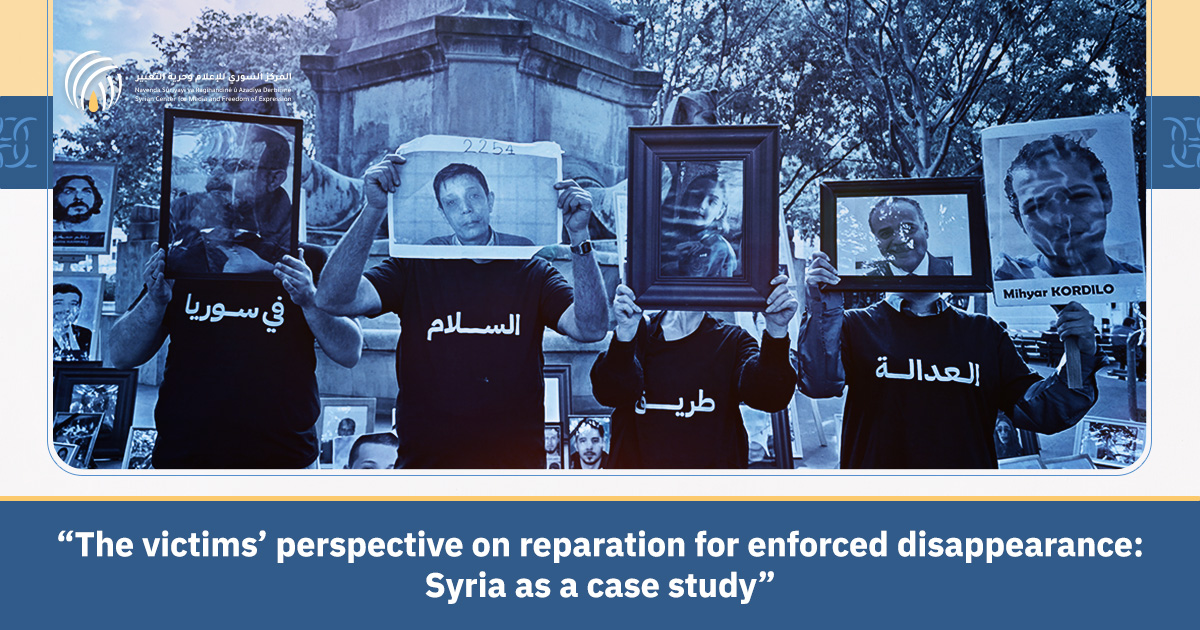The victims’ perspective on reparation for enforced disappearance: Syria as a case study
Syrians, by and large, are familiar with a folk saying that translates into something in line with the following: The mother of someone murdered can sleep, but the mother of someone threatened cannot sleep. This saying probably speaks of the relatives of tens of thousands of Syrians who are subject to enforced disappearance and are yearning for news about their fate or their whereabouts.
While enforced disappearance gained significant attention during the Syrian Conflict, which enters its 13th anniversary, its practice has been an issue in Syria for decades. Albeit not to the same extent witnessed in the last 13 years, it nevertheless was an issue during the conflict between the Syrian government and the Muslim Brotherhood and other political parties during the late seventies and early eighties of the last century. Apart from reports produced by concerned human rights organisations, atrocities that took place during that period remain unrecognised by the Syrian government, including any forms of reparation or justice. This includes recognition and reparation for thousands of Syrians who disappeared without a trace. In the current conflict, enforced disappearance has yet again been used as a weapon against dissentients.
The prohibition of enforced disappearance as an international crime is primarily articulated in the International Convention for the Protection of All Persons from Enforced Disappearance. Adopted by the United Nations General Assembly in 2006, the Convention outlines specific provisions that establish enforced disappearance as a crime under international law. As set out in Article 2, the term “enforced disappearance” applies to several types of actions, including arrest, detention, abduction, or other deprivations of liberty. Specifically, Article 2 states that an enforced disappearance occurs when the arrest, detention, abduction, or any other form of deprivation of liberty by agents of the state or by persons or groups of persons acting with the authorization, support, or acquiescence of the State, followed by a refusal to acknowledge the deprivation of liberty or by concealment of the fate or whereabouts of the disappeared person, which places such a person outside the protection of the law.
Consequently, Article 5 of the Convention mandates that the widespread or systematic practice of enforced disappearance constitutes a crime against humanity as defined in applicable international law and shall attract the consequences provided for under such applicable international law. In addition, each state party shall take the necessary measures to ensure that enforced disappearance constitutes an offence under its criminal law. This, according to Article 7, Each State Party shall make the offence of enforced disappearance punishable by appropriate penalties which take into account its extreme seriousness.
In 2010, a joint study on secret detention in counterterrorism, conducted by multiple United Nations Special Rapporteurs, reported that secret detentions are tantamount to enforced disappearances. Specifically, the study concluded that “all instances of clandestine detention implicitly qualify as enforced disappearances.” Therefore, it could be concluded that according to the agreed international definition, enforced disappearances involve state-sanctioned or state-supported abductions leading to secret captivity and deprivation of legal recourse.
However, it is important to note that Syria has not ratified the International Convention for the Protection of All Persons from Enforced Disappearance, and its domestic laws do not explicitly criminalize enforced disappearances. Moreover, the Convention does not recognise parties involved in the conflict other than official authorities and de-facto powers and forces. The conflict in Syria is complicated, and multiple international and non -international actors are involved as well as de-facto powers and forces. This is particularly significant given the prevalence of enforced disappearances during the Syrian civil war and government crackdowns on dissent. The conflict has resulted in the disappearance of over 130,000 individuals, with the numbers continuing to climb. Men, women, and children have been either abducted, killed, forcibly disappeared, or have gone missing while fleeing the violence along migratory routes.
Despite the gravity of these violations, arbitrary arrests, abductions, and forced disappearances are not addressed by justice and accountability mechanisms outlined in the UN Security Council Resolution 2254, which pertains to the Syrian situation. While the Syrian constitution emphasizes the sacred right to freedom and the state’s responsibility to safeguard the personal freedom, dignity, and security of citizens, the practical implementation of these constitutional provisions is compromised by actual practices and other legislative measures.
In the present Syrian context, where enforced disappearance is widely practiced as a repressive tactic, the legal frameworks for the prevention and remedy of disappearances are notably deficient or absent within Syrian statutes. Therefore, this research will explore reparation for enforced disappearance from the perception of Syrians who may have experienced enforced disappearance themselves or are relatives of someone who was a victim of enforced disappearance or is still missing. The research also focuses on how the participants understand reparation, how they envisage reparation measures in the future, whether reparation is possible in Syria, and their perception of the existing mechanisms that tackle enforced disappearance in Syria.





